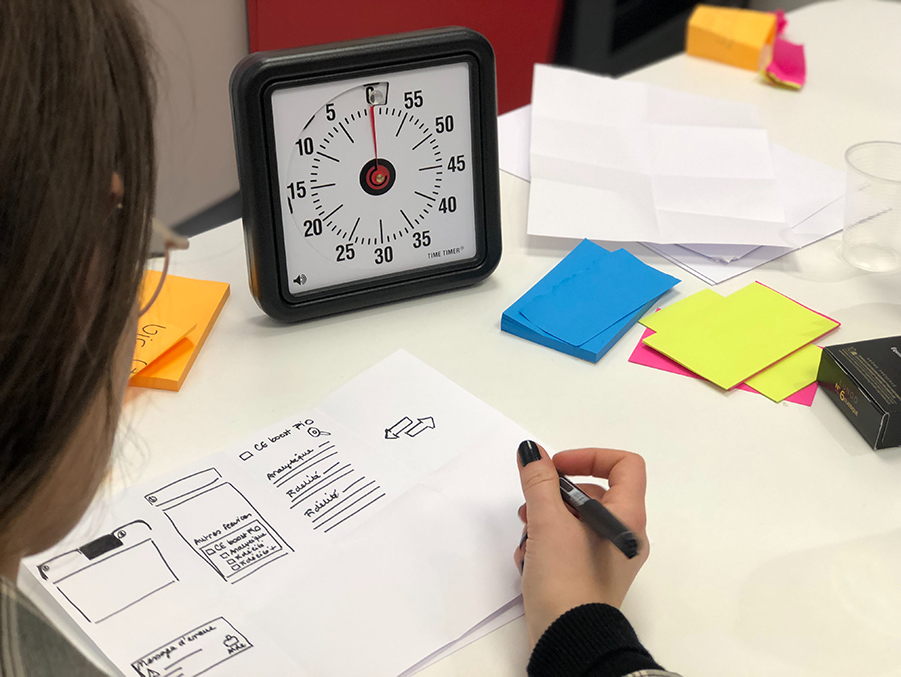Creativity doesn’t just happen.
The most inspired and innovative teams and individual designers need to be a part of a culture that enables forward-thinking, acceleration, and efficiency. It’s a combination of creative, analytical, and collaborative approaches that produce results.
It often starts with a trendy term – design thinking. Here we’ll look at how design thinking can open up a world possibility (and creativity) for designers.
Design Thinking

Design thinking isn’t relegated to designers and developers. It’s a collaborate, interdisciplinary approach to developing human-centered solutions with an iterative process.
You can think of it as a process, a mindset, a toolkit, or a way of doing business.
Design thinking as a buzzword keeps evolving and trending. You’ll find references to it in many disciplines and at all levels of business. And for good reason. When teams employ design thinking, it can be a valuable tool for problem-solving and innovating.
The Interaction Design Foundation describes it like this: “Design Thinking is a design methodology that provides a solution-based approach to solving problems. It’s extremely useful in tackling complex problems that are ill-defined or unknown, by understanding the human needs involved, by re-framing the problem in human-centric ways, by creating many ideas in brainstorming sessions, and by adopting a hands-on approach in prototyping and testing.”
In the simplest form and explanation, design thinking is a five-part process used to think about complex problems. The stages are:
- Empathize: To solve a problem, you have to understand it. Empathy is a crucial element of human experience and can help you feel the pain or challenge a problem present to the user. A deeper understanding can lead to a more effective solution.
- Define and visualize: Create a problem statement that shows the problem. Help create a picture of what needs to happen. In terms of product development, the define stage is where ideas for features, functionality, and usability might start to come together.
- Ideate and collaborate: The heavy creative lifting comes in the ideation phase. This might be where your team spends the most time developing ideas. Ideate with a “no bad ideas philosophy” to keep conversations happening and ideas flowing. The ideation phase should feel safe and open for everyone involved to speak and participate. Gathering as many ideas as possible can often be the key to finding an effective solution to the problem at hand.
- Prototype: Sketch it out. What do the solutions look like? How do they work? How are solutions implemented? Do they create the right user experience?
- Test: Try it out and be willing to accept failure as an opportunity to innovate further.
What’s most interesting about this process and way of thinking about innovation is that the process doesn’t always process in a straight line from step to step. Your team might get all the way to the prototyping phase, back up and ideate again or the testing phase could force you to go back and redefine the problem.
Design thinking gives teams the freedom to go through the stages of problem-solving in a non-linear way, working through the process using the steps and tools that most apply to the problem at hand.
Design Thinking Can Facilitate Growth
McKinsey & Company calls it part of business strategy: “Design is more than a feeling: it is a CEO-level priority for growth and long-term performance.”
It works because you create a methodology for problem-solving that has a focus on ideation.
McKinsey backs that value up with solid numbers as well. The top 25 percent of companies on the McKinsey Design Index had 32 percent higher revenue growth and 56 percent higher returns to shareholders.
Design Thinking Creates an Innovative and Creative Culture
Innovation doesn’t happen by chance. You can’t just tell a team “go design think and innovate.”
Management must create a culture where teams feel safe to collaborate, ideate, and innovate. How it looks can be different depending on the size of the team and how they interact as you try to implement a culture change.
Assessment and Exploration
A culture of innovation starts with knowing where your organization is today. Do teams have an ability, willingness, and opportunity for innovation? (The same questions and answers apply to freelancers as well: Do you have the appetite for innovation in design?)
All three have to exist to take the first steps toward building an innovation culture. And we won’t lie, it can be uncomfortable for some people and employees. Part of a culture assessment might be exploring what future hires look like to help further shape this mission.
Innovation Frameworks
Innovation can look a little different within every organization.
- Discovery workshops where you use brainstorming to create ideas and vote on potential outcomes.
- Ideation jams that involve a collaborative rapid idea generation session intended to develop a range of diverse solutions that address an issue while empowering participants to think creatively.
- Actionable future workshops that set vision and direction.
- Design sprints (periods of quick, timed iteration or design brainstorming) help establish an idea all the way to the concept phase.
- Solutioning, which maps workflows and can help companies with digital transformation projects.
- That’s why the core principles of design thinking are valuable because you can adapt to your specific needs.
- Think about creating an innovation culture as the problem. What’s your challenge? Define it and move from there into understanding and breaking that challenge down. Visualize the solution.
- Work with other members of the team to think about potential ways to create a solution. How do you start to establish a culture shift? Is It a new way of holding meetings? Is it incorporation design sprints into the problem-solving process? How do you encourage greater communication, ideation, and collaboration?
- Sketch it out and then test your design ideas.
Design Thinking Takes Culture, Strategy, and Structure

A highly productive and innovative team functions in a place where risk is part of the probable-solving process. It takes a delicate balance of culture, strategy, and structure to make it work.
Gary P. Pisano of the Harvard Business School says five almost paradoxical elements are needed to make the most of an innovation culture. These are the concepts that should drive strategy and the structure of new programs.
Organizations must be accepting of failure but can’t have tolerance for incompetence.
While experimentation is a positive, it must be controlled and disciplined so that business goals aren’t lost along the way.
Organization culture should provide a safe place for expressing ideas with a balance of candor and honesty. Not every idea is going to be the solution to a problem, and it should be acceptable to say so.
While collaboration is at the core of ideation, individuals must still be accountable for their own work.
Leadership must be strong, but not so heavy-handed that employees are held back from the ideation and creation process. Teams and individuals need the autonomy and authority to make decisions without being micro-managed. Leaders must set clear goals and benchmarks for success.
Conclusion
So while all of this might sound like a high-level theory, it has a lot of practical application for designers. What design thinking does is give you the freedom to explore ideas freely.
Design thinking gives you the chance to succeed – or fail – and try again. It brings together the idea that no website or app project is just finished. It can continue to evolve.
Using or trying to explore principles of design thinking will help you be more creative, innovative, and disruptive with design projects. And we all know these are the things that can truly make projects stand out.